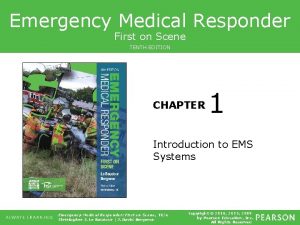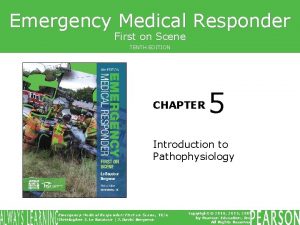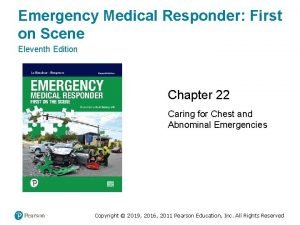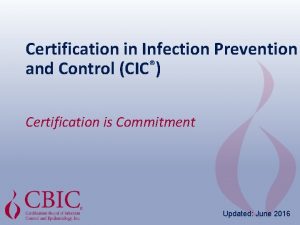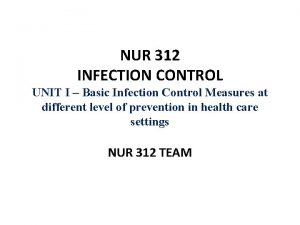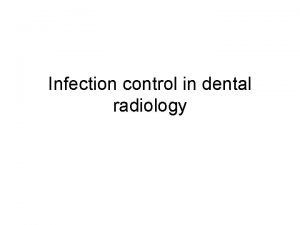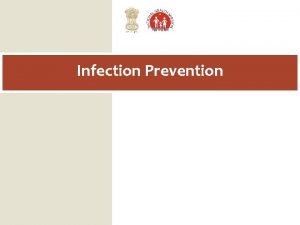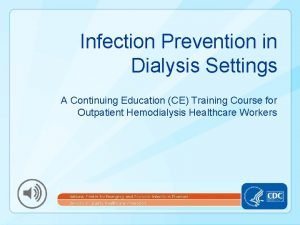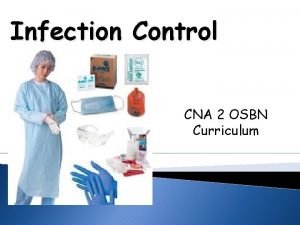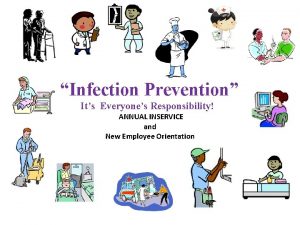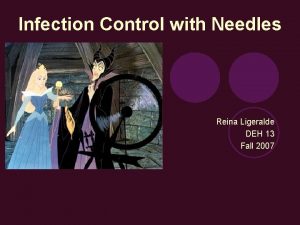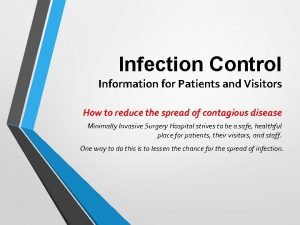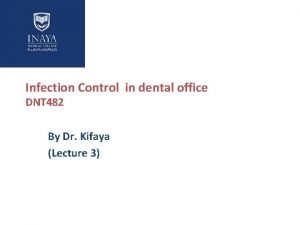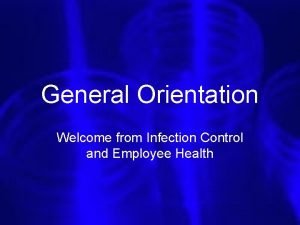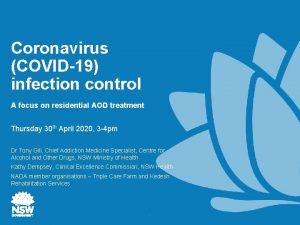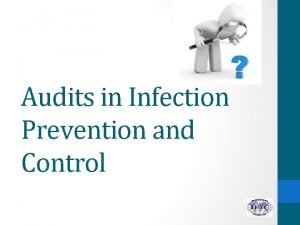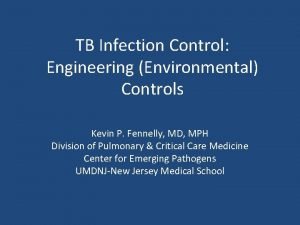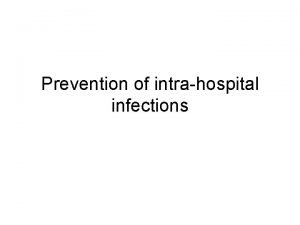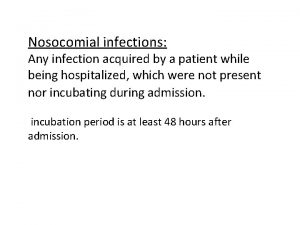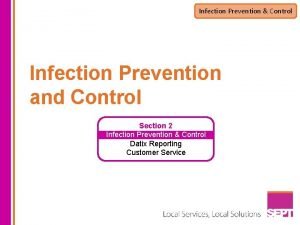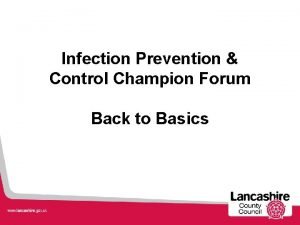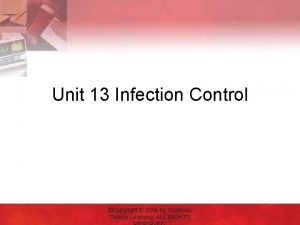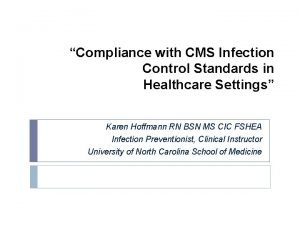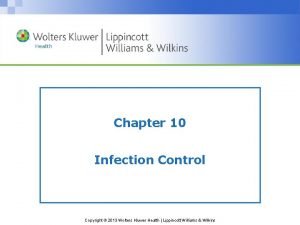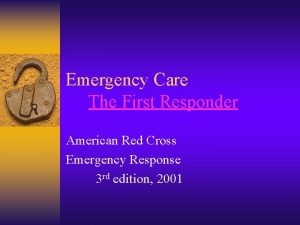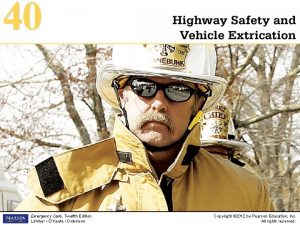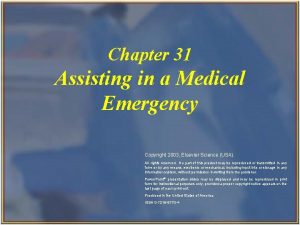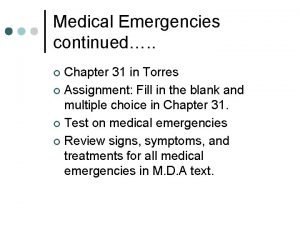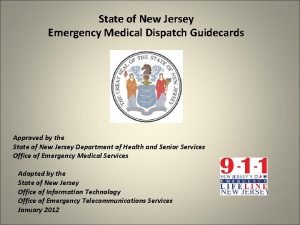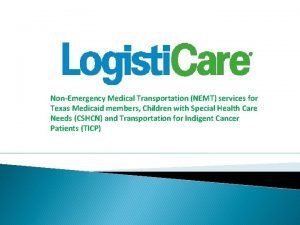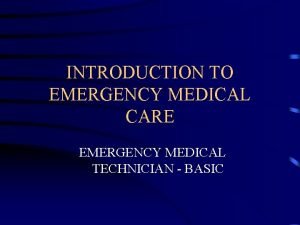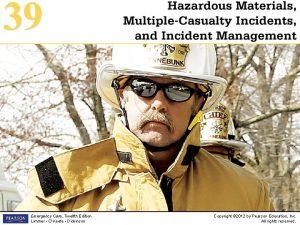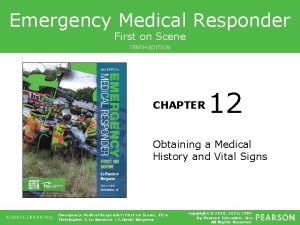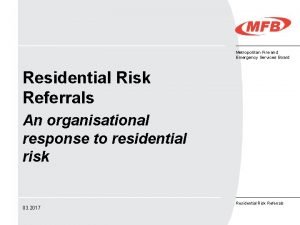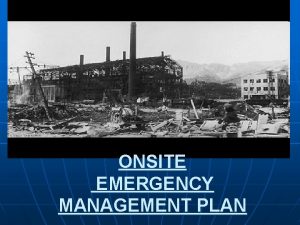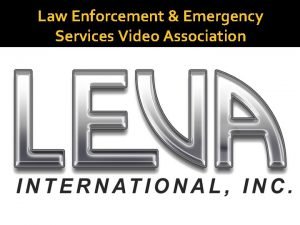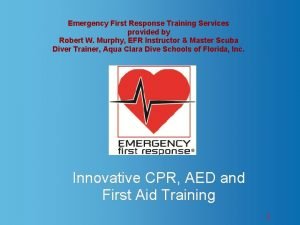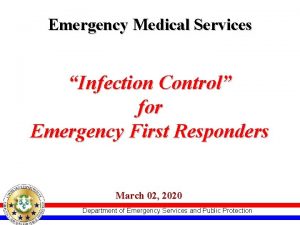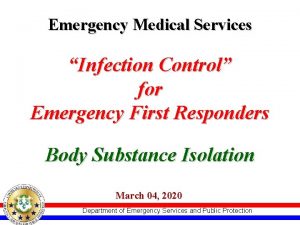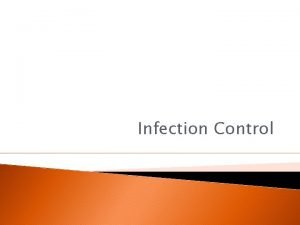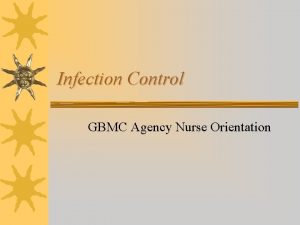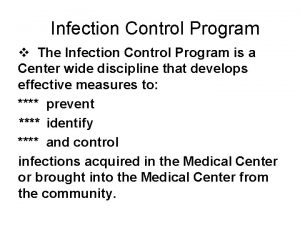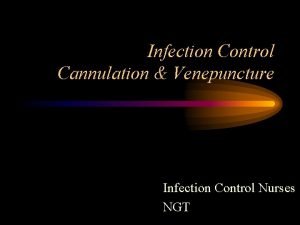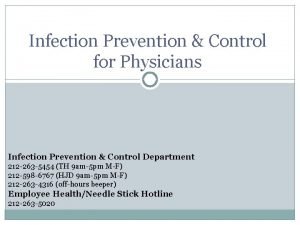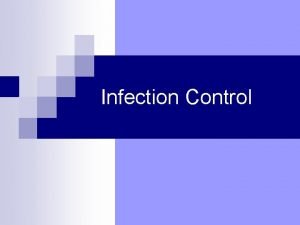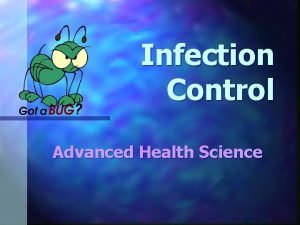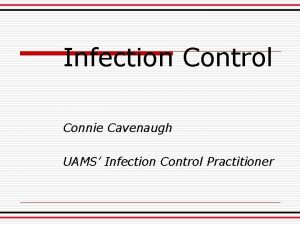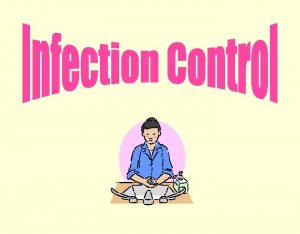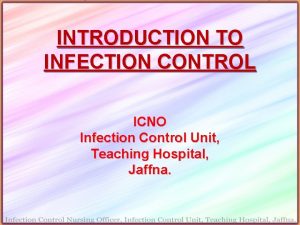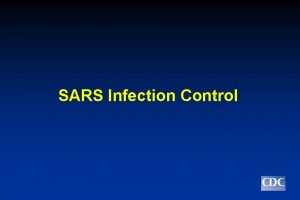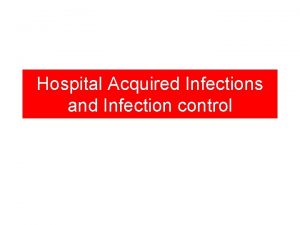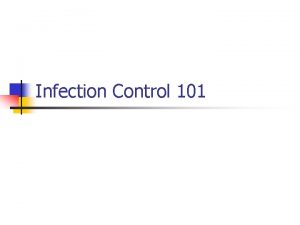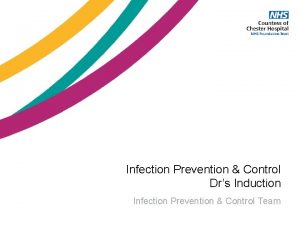Emergency Medical Services Infection Control for Emergency First


















































































































- Slides: 114

Emergency Medical Services “Infection Control” for Emergency First Responders October 01, 2014 Department of Emergency Services and Public Protection

Objectives: • • • Define Terminology & Concepts Identify Means of Transmission Identify Risk Factors Demonstrate P. P. E. Discuss Infection Control Policies and Procedures • Answer Questions Department of Emergency Services and Public Protection

Introduction • • • Welcome! Class Schedule Breaks Motivation Outline Department of Emergency Services and Public Protection

The Infection Control Plan • • • Brief Overview What is it? What does it do? Introduction to Your Plan Location Obtaining a Copy Department of Emergency Services and Public Protection

Applicable Laws and Standards 29 CFR 1910. 1030 29 CFR 1910. 134 29 CFR 1910. 1200 NFPA 1581 Ryan White Act Connecticut DPH / OEMS Center for Disease Control Department of Emergency Services and Public Protection

Communicable Diseases, Epidemiology & Symptoms Department of Emergency Services and Public Protection

Principles & Modes of Transmission Department of Emergency Services and Public Protection

Four Modes of Disease Transmission • Direct Contact • Indirect Contact • Airborne Transmission • Vector Transmission Department of Emergency Services and Public Protection

Four Elements of Transmission 1. Pathogen Communicability and Virulence 2. Quantity Dosage, Duration, & Frequency 3. Susceptibility Host Resistance Department of Emergency Services and Public Protection

Four Elements of Transmission 4. Entry Site – Exposure type • Significant • Non-Significant • Other Factor(s): – Organism Hardiness • Environmental Survivability Department of Emergency Services and Public Protection

Exposure Severity • Significant: – Mucosal • Eyes & Mouth Membranes – Percutaneous • Puncture, Non-Intact Skin, Human Bite • Non-Significant: – Clothing, Intact Skin Department of Emergency Services and Public Protection

Six Types of Pathogens • • • Viruses* Bacteria* Fungi Protozoa Rickettsia Parasitic Worms *Most Common Department of Emergency Services and Public Protection

Diseases of Concern For the Emergency Responder Department of Emergency Services and Public Protection

Some Diseases of Concern • Ebola • Enterovirus (EV-D 68) • Hepatitis • Herpes Zoster (Shingles) • HIV / Aids • Influenza • Meningitis • Tuberculosis Department of Emergency Services and Public Protection

Ebola • Ebola hemorrhagic fever (EHF) or simply Ebola is a disease of humans and other primates caused by Ebola viruses. • The virus is acquired by contact with blood or other body fluids of an infected human or other animal. • May also occur by direct contact with a recently contaminated item • May be able to transmit the disease via semen for nearly two months. Department of Emergency Services and Public Protection

Ebola Symptoms • • Fever (greater than 38. 6°C or 101. 4°F) Severe headache Muscle pain Weakness Diarrhea Vomiting Abdominal (stomach) pain Unexplained hemorrhage (bleeding or bruising) Department of Emergency Services and Public Protection

Enterovirus (EV-D 68) • Enteroviruses are a genus of positive-sense singlestranded RNA viruses associated with several human and mammalian diseases. • 71 human Enterovirus serotypes on the basis of antibody neutralization tests. • Enteroviruses affect millions of people worldwide each year, and are often found in the respiratory secretions (e. g. , saliva, sputum, or nasal mucus) and stool of an infected person. Department of Emergency Services and Public Protection

Enterovirus (EV-D 68) • Enterovirus: EV-D 68 was first identified in California in 1962. • Most people who get infected are infants, children and teens. • Infections with Enteroviruses are usually common in the United States during summer and fall. • There is no specific treatment for EV-D 68. Talk to your child's doctor about the best way to control his or her symptoms. Department of Emergency Services and Public Protection

Enterovirus (EV-D 68) Symptoms • Mild symptoms may include: – Fever – Runny nose – Sneezing – Cough – Body and Muscle aches • Severe symptoms may include: – Wheezing – Difficulty breathing Department of Emergency Services and Public Protection

Hepatitis Family • Viral hepatitis is the most common cause of hepatitis worldwide. • Most common causes of viral hepatitis are the five unrelated hepatotropic viruses: – – – hepatitis A hepatitis B hepatitis C hepatitis D (which requires hepatitis B to cause disease), hepatitis E Department of Emergency Services and Public Protection

Hepatitis Family • Transmission: – Fecal / Oral, Body fluids, blood • Symptoms: – – – Fever Loss of appetite/Nausea Jaundice Fatigue Headache Vaccine Available for Hep A Virus, Hep B Virus Department of Emergency Services and Public Protection

Herpes Simplex Virus • Herpes simplex virus 1 and 2 (HSV-1 and HSV-2), also known as human herpes virus 1 and 2 • Both HSV-1 (which produces most cold sores) and HSV-2 (which produces most genital herpes) are ubiquitous and contagious. • Herpes simplex can be spread through contact with saliva, such as sharing drinks. • A cure for herpes has not yet been developed. Once infected, the virus remains in the body for life. Department of Emergency Services and Public Protection

HSV-1 (Cold Sores) & HSV-2 (Genital) • Transmission: – Transmitted by direct contact with a lesion or the body fluid of an infected individual – Fingers are at particular risk. • Symptoms: – Lesions around mouth, Malaise, Sore Throat No vaccine available Department of Emergency Services and Public Protection

Herpes Zoster (Shingles) • The initial infection with Varicella Zoster Virus (VZV) causes the acute, short-lived illness chickenpox which generally occurs in children and young adults. • Once an episode of chickenpox has resolved, the virus is not eliminated. Department of Emergency Services and Public Protection

Herpes Zoster (Shingles) • Transmission: – As with chickenpox and / or other forms of herpes, direct contact with an active rash can spread VZV to a person who has no immunity to the virus. This newly infected individual may then develop chickenpox, but will not immediately develop shingles. Department of Emergency Services and Public Protection

Herpes Zoster (Shingles) • Earliest symptoms of herpes zoster: – Headache – Fever – Malaise • Followed by sensations of: – burning pain – itching – hyperesthesia (oversensitivity) or – paresthesia (“pins and needles”) • tingling, pricking, or numbness Department of Emergency Services and Public Protection

HIV / AIDS • The Human Immunodeficiency Virus (HIV) is a lentivirus (a subgroup of retrovirus) that causes the Acquired Immunodeficiency Syndrome (AIDS). • Infection with HIV occurs by the transfer of blood, semen, vaginal fluid, pre-ejaculate, or breast milk Department of Emergency Services and Public Protection

HIV / AIDS • Transmission: – Blood – Body fluids with blood • Symptoms: – – Fever Cough Night sweats Weight loss No vaccine available Department of Emergency Services and Public Protection

Influenza • Influenza, commonly known as "the flu", is an infectious disease of birds and mammals caused by RNA viruses of the family Orthomyxoviridae, • Typically, influenza is transmitted through the air by coughs or sneezes, creating an aerosol containing the virus. • Influenza can also be transmitted by direct contact with bird droppings or nasal secretions, or through contact with contaminated surfaces Department of Emergency Services and Public Protection

Influenza • Most common symptoms are: – – – – – chills fever runny nose sore throat muscle pains headache (often severe) coughing weakness / fatigue general discomfort Department of Emergency Services and Public Protection

Meningitis • An acute inflammation of the protective membranes covering the brain and spinal cord, known collectively as the meninges. • May be caused by infection with viruses, bacteria, or other microorganisms Department of Emergency Services and Public Protection

Meningitis • Bacterial (Rare) – Transmission: • Direct Contact with Oral / Nasal Secretions • Intimate or Direct Exposure (i. e. Kissing) – Symptoms: • • Fever >101 F, Sudden Severe Headache Neck / Back Stiffness Mental Changes Rashes Vaccine available Department of Emergency Services and Public Protection

Meningitis • Viral (Common) – Transmission: • Fecal / Oral – Symptoms: • Same as Bacterial; Also possible: – Abdominal discomfort – Chest pain – Rash No vaccine available Department of Emergency Services and Public Protection

Tuberculosis • Tuberculosis typically attacks the lungs, but can also affect other parts of the body. • Spread through the air when people who have an active TB infection cough, sneeze, or otherwise transmit respiratory fluids through the air • The Mantoux tuberculin skin test is often used to screen people at high risk for TB Department of Emergency Services and Public Protection

Tuberculosis • Transmission: – Airborne • Symptoms: – Fever – Night Sweats – Weight loss – Fatigue Vaccine available Department of Emergency Services and Public Protection

Other Diseases of Concern • • Anthrax Chickenpox Smallpox Lyme MRSA Pneumonia (Bacterial & Viral) West Nile Department of Emergency Services and Public Protection

Anthrax • Anthrax is an acute disease caused by the bacterium Bacillus anthracis. • Most forms of the disease are lethal • Anthrax can enter the human body through the intestines (ingestion), lungs (inhalation), or skin (cutaneous) • Anthrax does not usually spread from an infected human to a non-infected human. • Effective vaccines against anthrax are now available Department of Emergency Services and Public Protection

Chickenpox • Chickenpox is a highly contagious disease caused by primary infection with Varicell Zoster Virus (VZV). • Chickenpox is an airborne disease which spreads easily through coughing or sneezing Department of Emergency Services and Public Protection

Smallpox • Smallpox was an infectious disease caused by either of two virus variants, Variola major and Variola minor. • Transmission occurs through inhalation of airborne variola virus, usually droplets expressed from the oral, nasal, or pharyngeal mucosa of an infected person • Smallpox is highly contagious, but generally spreads more slowly and less widely than some other viral diseases Department of Emergency Services and Public Protection

Smallpox • Incubation period is 12 -14 days • Characteristic rash appears 2 -3 days after nonspecific, flu-like prodrome (fever and headache) • Rash begins on face, hands, forearms and spreads to legs and centrally to trunk; Lesions are more predominant on the extremities than the trunk Department of Emergency Services and Public Protection

Smallpox Eczema Vaccinatum Department of Emergency Services and Public Protection

And… More Diseases… • • German Measles (Rubella) Lice Measles Mononucleosis Mumps Scabies Syphilis Department of Emergency Services and Public Protection

Incubation Period(s) • • Anthrax Ebola Hep. Family HIV/AIDS Meningitis TB Chickenpox Pneumonia • • 1 to 7 days 21 Days 25 days or more >3 Months 2 to 10 days 2 to 12 weeks 14 to 16 days Several days Why is this important to know? Department of Emergency Services and Public Protection

Infection Control Plan Health Maintenance System: Concept & Components Department of Emergency Services and Public Protection

Health Maintenance (HM) Concept “A system to optimize the health of employees, and to minimize the risk of occupationally acquired illness or injury” A. K. A. “Risk Management!” Department of Emergency Services and Public Protection

HM System Components • • • Physical Exam Immunizations PPE Post-exposure protocol Member assistance programs Department of Emergency Services and Public Protection

Physical Examination Department of Emergency Services and Public Protection

Physical Examination • Pre-entry health assessment – Initial exam – Determination of baseline – Fitness for service • On Going Assessment – Repeat exams as determined by MD Department of Emergency Services and Public Protection

Immunizations Proactive Infection Control Department of Emergency Services and Public Protection

Immunizations • Proactive program offers protection to: – Employee – Spouse / family members of employee – Emergency response organization – Patients • Frequency: – Initial – Annual Department of Emergency Services and Public Protection

Common Vaccinations • HBV or A/B combo – OSHA requirement to be offered (HBV) • 1910. 1030(f)(1)(i) • Declination statement – 1910. 1030 App A – Three shot series – Titer recommended by CDC • As of 02/09/1990 Department of Emergency Services and Public Protection

Common Vaccinations • • Diphtheria-Pertussis-Tetanus (DPT) Measles-Mumps-Rubella (MMR) Polio Influenza Pneumonia Chickenpox Smallpox Department of Emergency Services and Public Protection

Personal Protective Equipment Usage Concepts Department of Emergency Services and Public Protection

Universal Precautions “Precautions taken to prevent occupational risk exposure to blood and other bodily fluids. ” Universal Precautions now referred to as “Standard Precautions” Often “Body Substance Isolation” used in its’ place by First Responders Department of Emergency Services and Public Protection

Body Substance Isolation (BSI) “An infection control strategy that considers all body substances as potentially infectious. ” Similar to Universal Precautions. . But goes further in isolating workers from Pathogens Department of Emergency Services and Public Protection

“Two” Levels of B. S. I. – P. P. E. • “Standard” Level of B. S. I. – Everyday calls, First Responder Protection • “Isolation” Level of B. S. I. (special circumstances) – Full Body Protection – No Skin Exposed Department of Emergency Services and Public Protection

“Standard” Recommended P. P. E. • • • Gloves Eye / Face splash protection Splash Protection – Gowns N 95 or N-100 mask Disposable resuscitation equipment Department of Emergency Services and Public Protection

“Standard” P. P. E. – Gloves Department of Emergency Services and Public Protection

“Standard P. P. E. – Eye Protection Department of Emergency Services and Public Protection

“Standard” P. P. E. – Gowns Aprons Gowns Department of Emergency Services and Public Protection

“Standard” P. P. E. – Respiratory Respirators that filter out at least 95% of airborne particles during “worse case” testing using a “most-penetrating” sized particle are given a "95" rating. Those that filter out at least 99% receive a “ 99” rating. And those that filter at least 99. 97% (essentially 100%) receive a “ 100” rating. Department of Emergency Services and Public Protection

“Standard” P. P. E. – Kits Department of Emergency Services and Public Protection

Disposable Respiratory Devices Department of Emergency Services and Public Protection

“Isolation” P. P. E. • • Gloves – Double Glove Eye / Face splash protection – NO GOGGLES Gowns / Coveralls – Complete Body Coverage Hood – if not part of Splash Protection or PAPR Ensemble • Respiratory Protection: PAPR or N 95 (Powered Air Purifying Respirator) • Boot Covers – if not using a one piece suit • Disposable Resuscitation Equipment Department of Emergency Services and Public Protection

“Isolation” P. P. E. – Gloves Double Glove is highly recommended; First Pair put on first under sleeve cuff Second Glove over top on top of Sleeve Cuff Department of Emergency Services and Public Protection

“Isolation” P. P. E. – Eye Protection CDC is recommending full face shields or full hoods for eye protection. Googles / Glasses tend to “Fog” – Responders then place hands near the eyes to move goggles, thus potentially exposing to disease Department of Emergency Services and Public Protection

“Isolation” P. P. E. – Gown / Coveralls Department of Emergency Services and Public Protection

“Isolation” P. P. E. – Hoods offer more body protection, usually require PAPR air supply Department of Emergency Services and Public Protection

“Isolation” P. P. E. – Respiratory Powered Air Purifying Respirators (PAPR) are recommended for long duration work capacity and reliability Department of Emergency Services and Public Protection

“Isolation” P. P. E. – Boot Covers Knee high boot covers are recommended depending on the type of protective suit / coveralls being used Department of Emergency Services and Public Protection

“Isolation” P. P. E. – Ventilation Equipment Department of Emergency Services and Public Protection

Personal Protective Equipment • • • Proper usage Storage location(s) Proper removal On scene self decontamination Hand Washing Disposal Department of Emergency Services and Public Protection

Post Exposure Protocol Critical Information for the Responder Department of Emergency Services and Public Protection

What Do You Do? You’re operating at the scene of a stressful emergency; You think you’ve just been exposed to blood or body fluids… What do you do? Who do you notify? Should you go to the hospital? Department of Emergency Services and Public Protection

Post Exposure System A post exposure system establishes uniform procedures to protect the health of responders after a possible exposure to communicable diseases Department of Emergency Services and Public Protection

Post Exposure System • The “Players” – Responders – Supervisors – Infection Control Administrator (ICA) – Infection Control Practitioner (ICP) – Agency Physician (Fire / EMS / Law Enforcement) – Health Department of Emergency Services and Public Protection

Post Exposure System • Components: Notification Verification Treatment / Follow-up care Documentation Counseling Department of Emergency Services and Public Protection

Post Exposure System • Notification Phase – Responder: • Exposure is perceived • Reports verbally to IC • Completes exposure report – Significant vs. non-significant exposure • Contacts workers’ comp. Hotline • Notifies Infection Control Administrator Department of Emergency Services and Public Protection

Post Exposure System • Notification Phase – Supervisor (IC) • Visually verifies exposure when feasible • Ensures decon and treatment when needed • Endorses exposure report • Contacts Infection Control Administrator • Verifies workers’ comp. has been called Department of Emergency Services and Public Protection

Post Exposure System • Verification Phase – Starts on scene • IC attempts to verify exposure – ICA schedules medical exam • Primarily for significant exposures • Recommended within 48 hours – ICA contacts receiving facility • Ryan White Care Act Department of Emergency Services and Public Protection

Ryan White Care Act This act delineates specific notification requirements that allow responders to find out if they have been exposed to an “infectious disease. ” Department of Emergency Services and Public Protection

Ryan White Care Act • Routine Notification – The hospital notifies transporting responders of a potential exposure • Within 48 hours • Does not apply to non-transporting responders • ICP contacts ICA • Confidential! Department of Emergency Services and Public Protection

Ryan White Care Act • Notification by Request – Initiated by local ICA – ICA contacts receiving facility ICP – Reply within 48 hours • An exposure took place • An exposure did not take place • Insufficient information / undetermined – Confidential! Department of Emergency Services and Public Protection

Confidentiality Issues • You’ve been exposed… – Privacy act limits information that can be given to ICA or CEO by ICP / MD – All information is confidential – You may give your consent – Reality check • How hard is it to keep a secret in your agency? Department of Emergency Services and Public Protection

Post Exposure System • Treatment Phase – May start on scene – Medical Evaluation w/in 48 hours – Testing • Initial and follow-up • Incubation period – Treatment • May be long term • Prophylactics Department of Emergency Services and Public Protection

Post Exposure System • Documentation Phase – Exposure record – Injury / illness report – Workers’ compensation – OSHA Department of Emergency Services and Public Protection

Post Exposure System • Documentation Phase – ICA conducts follow up review • Within a reasonable period of time – Considerations? • Does responder need retraining? • Does Agency need to alter current procedures? • How can this be prevented from happening again? Department of Emergency Services and Public Protection

Post Exposure System • Counseling Phase – Peer support / CISD – Stress management – Spousal or family counseling – Family protection (e. g. Safe sex practices) – Retraining in infection control, if needed Department of Emergency Services and Public Protection

Incident Operations & Recovery The Infection Control Process Department of Emergency Services and Public Protection

Incident Operations & Recovery • Four phases of response – Preparation for response – Response – Scene management – Post-response recovery Department of Emergency Services and Public Protection

Preparation Phase • IC Training • SOP/SOG Enforcement • Storage of PPE (vehicles & station) – Regular inventory, maintenance • Personal Hygiene – In and out of the station Department of Emergency Services and Public Protection

Response Phase • Evaluation of dispatch information – A. K. A. “Size-up” • Don PPE en route when possible • Prepare mentally • Confidentiality and the radio Department of Emergency Services and Public Protection

Scene Management Phase • Operations at scene – Use BSI / PPE – Limit patient contact – Use mechanical resuscitation devices – Do not recap needles – Handle sharps only when necessary Department of Emergency Services and Public Protection

In health care workers, 80% of exposures are due to sharps injuries. The greatest percentage of needle-stick accidents occur during recapping! Department of Emergency Services and Public Protection

Scene Management Phase • Operations at scene – Use mechanical clean up methods (e. g. Dust pan & brush) – Properly dispose of waste • Appropriate containers – Properly package contaminated gear • Transport to fire station safely Department of Emergency Services and Public Protection

Scene Management Phase • Public relations at the scene – Explain universal precautions • If patient is uncomfortable with gloves, etc. – Reasonable BSI (e. g. Coveralls for chest pains is overkill) Department of Emergency Services and Public Protection

Scene Management Phase • Public information at the scene – Patient’s medical status confidential • Do not broadcast – Use care when discussing patient’s information at scene • Medical information is “need to know” Department of Emergency Services and Public Protection

Post Response Phase • Proper disposal of PPE – Appropriate containers • Red “Bio” bags • Sharps containers – Designated decon area • Immediate decon (In house) • Storage for out-of-house decon Department of Emergency Services and Public Protection

Post Response Phase • Disinfection, Decon, & Cleaning – Four level’s of disinfection: • Low level – Routine ambulance cleaning • Intermediate – Typical post response • High level – (ie. Intubation equipment) • Sterilization – Destroys all micro-organisms Department of Emergency Services and Public Protection

Disinfection • Low level: – Routine housekeeping – Routine Cleaning – Removal of soil in absence of visible body fluids Department of Emergency Services and Public Protection

Disinfection • Intermediate level: – – – Destroys mycobacterium TB Vegetative Bacteria Most viruses & Fungi NOT Bacterial spores Typical method for ambulances Department of Emergency Services and Public Protection

Disinfection • Intermediate level: – Three types: • EPA registered Disinfectant • Commercially available hard surface germicides • Water-Chlorine Bleach (1: 100) – 2 cups bleach to 1 gal. water Department of Emergency Services and Public Protection

Disinfection • High level: – Destroys all forms of micro-organisms • Except large numbers of bacterial spores – Required for reusable instruments • Contact with mucous membranes (i. e. Laryngoscope blades) Department of Emergency Services and Public Protection

Disinfection • Sterilization: – Destroys all micro-organisms – Usually not practical for EMS Department of Emergency Services and Public Protection

Post Response Phase • Equipment Decontamination – Conducted in designated area – Use appropriate PPE – Gross Decon • Mild soap & water – Use appropriate level disinfectant – Air dry in clean storage area Department of Emergency Services and Public Protection

Post Response Phase • Cleaning of PPE - Uniforms – Decon ASAP upon returning – Store appropriately until laundering – Launder in designated front loading washer or commercially – Follow manufacturers instructions – No chlorine bleach on turnout gear – Do not bring home! Department of Emergency Services and Public Protection

Post Response Phase • Wash Hands and Exposed Skin Often • Wash Thoroughly • Wash with Anti-Bacterial Soap Department of Emergency Services and Public Protection

Station / Home Issues • Equipment Storage – Ensure proper storage equipment / supplies – Monitor usage levels for inventory Control – Monitor shelf life – Maintain SDS’s Department of Emergency Services and Public Protection

Station / Home Issues • Laundry Issues: – Commercial front loading washer • Automatic pre-metered detergent • Computerized cycles • High temperature • Water completely drains out • Again… Do not bring home! Department of Emergency Services and Public Protection

Station / Home Issues • Designated decontamination area – Separate room, properly marked, secure – Proper ventilation – Adequate drainage, including floor – Non-porous sink with hot & cold water – Automatic water for hand washing – Rack/shelves for drying – Appropriate supplies Department of Emergency Services and Public Protection

Program Evaluation • On-going risk assessment – Annual Re-Evaluation of: • Administrative controls (Management Policy) • Engineering controls (Physical changes to the workplace) • Work practice controls (Modified methods) • PPE • Vaccinations Department of Emergency Services and Public Protection

Program Evaluation • Annual record review – Safety committee • Sharps log • Injury log • Exposure reports Safety Committee Department of Emergency Services and Public Protection

Summary Questions & Answers Department of Emergency Services and Public Protection

Marc A. Scrivener Fire Service Instructor & Connecticut Fire Academy Staff Department of Emergency Services and Public Protection
 Emergency medical responder first on scene
Emergency medical responder first on scene Cardiopulmonary
Cardiopulmonary Emergency medical responder first on scene 11th edition
Emergency medical responder first on scene 11th edition Radiographic errors in dentistry ppt
Radiographic errors in dentistry ppt Fungi milady
Fungi milady Chapter 16 infection prevention and control
Chapter 16 infection prevention and control Chapter 16 infection control and standard precautions
Chapter 16 infection control and standard precautions Chapter 15:9 maintaining transmission based precautions
Chapter 15:9 maintaining transmission based precautions Chapter 15:8 using sterile techniques
Chapter 15:8 using sterile techniques Cic certification
Cic certification Infection control meaning
Infection control meaning Darkroom infection control guidelines
Darkroom infection control guidelines Learning objectives for infection control
Learning objectives for infection control Conclusion of infection
Conclusion of infection Cna infection control
Cna infection control Certification board of infection control and epidemiology
Certification board of infection control and epidemiology Infection control is everyone's responsibility
Infection control is everyone's responsibility Infection control
Infection control Tier 1 standard precautions
Tier 1 standard precautions Infection control information
Infection control information Root locus drawer
Root locus drawer Infection control orientation
Infection control orientation Infection control
Infection control Infection control audits
Infection control audits Environmental controls infection control
Environmental controls infection control Another name for customer
Another name for customer Infection control committee
Infection control committee Conclusion of infection control
Conclusion of infection control Rigid thinking examples
Rigid thinking examples Infection control champion
Infection control champion Unit 13 infection control
Unit 13 infection control Infection control surveyor worksheet
Infection control surveyor worksheet Chapter 10 infection control
Chapter 10 infection control Red cross first responder
Red cross first responder Introduction to emergency medical care
Introduction to emergency medical care Chapter 31 assisting in a medical emergency
Chapter 31 assisting in a medical emergency Define medical emergency chapter 31
Define medical emergency chapter 31 Medical emergency student lectures
Medical emergency student lectures Emergency medical dispatch guidecards
Emergency medical dispatch guidecards Texas nemt
Texas nemt Introduction to emergency medical care
Introduction to emergency medical care Introduction to emergency medical care
Introduction to emergency medical care Ac vein
Ac vein Introduction to emergency medical care
Introduction to emergency medical care Metropolitan fire and emergency services board
Metropolitan fire and emergency services board National emergency services academy
National emergency services academy Onsite emergency services
Onsite emergency services Law enforcement video association
Law enforcement video association Emergency response training services
Emergency response training services Iso 22301 utbildning
Iso 22301 utbildning Novell typiska drag
Novell typiska drag Tack för att ni lyssnade bild
Tack för att ni lyssnade bild Ekologiskt fotavtryck
Ekologiskt fotavtryck Shingelfrisyren
Shingelfrisyren En lathund för arbete med kontinuitetshantering
En lathund för arbete med kontinuitetshantering Adressändring ideell förening
Adressändring ideell förening Tidbok
Tidbok Sura för anatom
Sura för anatom Förklara densitet för barn
Förklara densitet för barn Datorkunskap för nybörjare
Datorkunskap för nybörjare Stig kerman
Stig kerman Mall för debattartikel
Mall för debattartikel Delegerande ledarstil
Delegerande ledarstil Nyckelkompetenser för livslångt lärande
Nyckelkompetenser för livslångt lärande Påbyggnader för flakfordon
Påbyggnader för flakfordon Arkimedes princip formel
Arkimedes princip formel Svenskt ramverk för digital samverkan
Svenskt ramverk för digital samverkan Jag har gått inunder stjärnor text
Jag har gått inunder stjärnor text Presentera för publik crossboss
Presentera för publik crossboss Jiddisch
Jiddisch Bat mitza
Bat mitza Klassificeringsstruktur för kommunala verksamheter
Klassificeringsstruktur för kommunala verksamheter Luftstrupen för medicinare
Luftstrupen för medicinare Claes martinsson
Claes martinsson Centrum för kunskap och säkerhet
Centrum för kunskap och säkerhet Verifikationsplan
Verifikationsplan Bra mat för unga idrottare
Bra mat för unga idrottare Verktyg för automatisering av utbetalningar
Verktyg för automatisering av utbetalningar Rutin för avvikelsehantering
Rutin för avvikelsehantering Smärtskolan kunskap för livet
Smärtskolan kunskap för livet Ministerstyre för och nackdelar
Ministerstyre för och nackdelar Tack för att ni har lyssnat
Tack för att ni har lyssnat Referat mall
Referat mall Redogör för vad psykologi är
Redogör för vad psykologi är Stål för stötfångarsystem
Stål för stötfångarsystem Atmosfr
Atmosfr Borra hål för knoppar
Borra hål för knoppar Vilken grundregel finns det för tronföljden i sverige?
Vilken grundregel finns det för tronföljden i sverige? Standardavvikelse
Standardavvikelse Tack för att ni har lyssnat
Tack för att ni har lyssnat Rita perspektiv
Rita perspektiv Vad är verksamhetsanalys
Vad är verksamhetsanalys Tobinskatten för och nackdelar
Tobinskatten för och nackdelar Toppslätskivling dos
Toppslätskivling dos Mästare lärling modell
Mästare lärling modell Egg för emanuel
Egg för emanuel Elektronik för barn
Elektronik för barn Plagg i rom
Plagg i rom Strategi för svensk viltförvaltning
Strategi för svensk viltförvaltning Var 1721 för stormaktssverige
Var 1721 för stormaktssverige Ellika andolf
Ellika andolf Ro i rom pax
Ro i rom pax Tack för att ni lyssnade
Tack för att ni lyssnade Enheter för massa
Enheter för massa Cirkelkomposition dikt
Cirkelkomposition dikt Inköpsprocessen steg för steg
Inköpsprocessen steg för steg Fuktmätningar i betong enlig rbk
Fuktmätningar i betong enlig rbk Ledarskapsteorier
Ledarskapsteorier Kolopskopi
Kolopskopi Myndigheten för delaktighet
Myndigheten för delaktighet Frgar
Frgar Sju principer för tillitsbaserad styrning
Sju principer för tillitsbaserad styrning Läkarutlåtande för livränta
Läkarutlåtande för livränta Tät skog karttecken
Tät skog karttecken Gumman cirkel sång
Gumman cirkel sång
